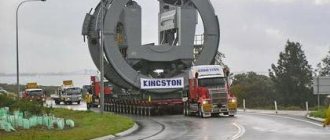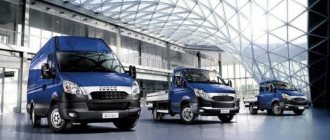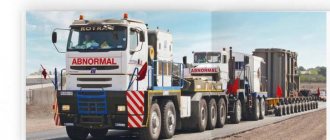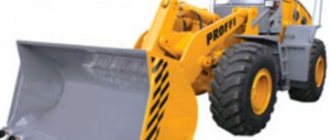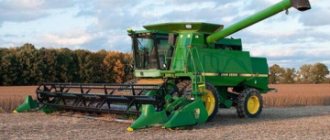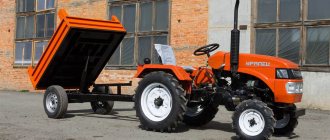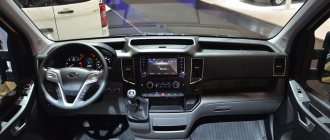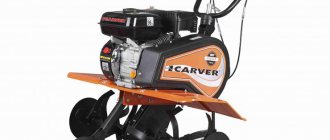The Hyundai HD 170 truck belongs to the category of medium-duty vehicles, its carrying capacity is more than 10.5 tons. It can be used in populated areas and when transporting goods to other cities. Despite its impressive dimensions, the vehicle is characterized by maneuverability, the turning radius is 7.5 m. The platform is installed on a pair of bridges. Depending on the modification, platforms 8 m and 9.5 m long can be used.
Hyundai HD 170 truck
The endurance and pickiness of the equipment allow it to demonstrate productivity when working on Russian roads and low-quality fuel. These factors became the reason for the popularity of the Hyundai hd 170 truck, as well as the lack of need for frequent repair work.
Return to content
Features and Benefits
Despite its unprepossessing appearance, the machine is functional and convenient. This is ensured by a separate cab and body. The design has rough, angular shapes, but the interior space is entirely focused on driver comfort. The main advantages of the Hyundai HD 170 truck include:
- versatility, allowing the use of equipment when transporting goods over long and short distances;
- ease of loading and unloading of goods due to the low base;
- efficiency due to the consumption of 25 liters of diesel per 100 km;
- low starting cost of the truck and affordable price for maintenance;
- comfort provided by a large viewing angle, high-quality air conditioning and air suspension of the chair;
- reliability that can compete with American and European analogues;
- efficiency when working in difficult conditions.
Hyundai HD 170 crane
Hyundai HD170 van
The Hyundai HD 170 truck can be supplied with various models of chassis add-ons:
- tank;
- crane arm;
- tow truck;
- garbage truck;
- manufactured goods vans, flatbed vans, refrigerated vans;
- mobile laboratory, etc.
Return to content
Truck configurations
Dimensions of the Hyundai HD 170
Despite the complete lack of aerodynamic qualities, the HD 170 truck is produced with an emphasis on ergonomics and comfort. The basic configuration of this model has the following components:
- sleeping cabin;
- collector heating system;
- hydraulic power steering;
- mountain braking system;
- built-in audio system;
- electric windows;
- lighting for steps;
- pneumatic hand brake;
- tachometer;
- fog lights;
- a set of standard tools.
The more expensive package includes all standard components. At the same time, it is additionally equipped with:
- built-in climate system;
- Gearbox with power selection;
- electric spring cabin lift system;
- heating of the berth;
- 12-volt converter.
Since the truck is ideal for long-distance transportation, during its production, special attention was paid to the comfort of truck drivers. The illuminated steps have anti-slip sheathing. The voluminous windshield provides excellent visibility from the cabin, and thanks to three windshield wipers, it is efficiently cleaned in the most necessary places. The beautifully designed headlights give the truck not only aesthetics, but also powerful long-range illumination of the road.
The cabin has high-quality sound and vibration insulation, which adds comfort. The truck cabin is placed on soft rubber cushions, which are designed to improve shock-absorbing qualities.
The design of the HD 170 truck provides for the placement of manipulator units (CMU). For example, the Soosan CMU with a load moment of 11 t/m makes it possible to load objects that are below the surface level where the truck is located.
Technical characteristics and dimensions
Technical characteristics of the Hyundai HD 170 are:
| turning radius | 7.5/10.1 m depending on the length of the platform; |
| front/rear axle load | 6.3/10.8 t; |
| drive unit | 4x2; |
| overhang in front | 1.5 m; |
| ground clearance | 0.285 m; |
| front/rear track | 2.04/1.85 m; |
| wheelbase | 4.4/5.85 m depending on the length of the platform; |
| weight | 17.1 t. |
The dimensions of the machine are, depending on the modification:
- 7.93 m x 2.5 m x 2.92 m - short;
- 9.53 m x 2.5 m x 2.91 m - long.
Dimensions of the short version
Return to contents
What is a truck?
Hyundai HD 170 is considered one of the most powerful and largest trucks produced by Hyundai, located in Korea. The transport is designed to transport cargo over 10 tons. The platform is placed on two axles. The Russian freight transport market offers the Hyundai HD 170 in two different versions:
- platform 8 m long;
- platform 9.5 m long (Long).
The weight of the truck itself is 17.1 tons, which is why the model is called HD 170. The vehicle has performed well on domestic roads, and it is not picky about local fuel. Thanks to these advantages, the Hyundai HD 170 has gained high popularity in Russia. Numerous reviews from owners indicate that the truck does not require frequent repairs due to its extraordinary endurance. It is sufficient to carry out maintenance for preventive reasons.
Engine
The equipment is equipped with its own model D6GA with a capacity of 255 horsepower. The 5.9-liter six-cylinder engine consumes diesel fuel and its exhaust quality complies with Euro 4 standards. The power plant is capable of developing torque up to 932 Nm and vehicle speed up to 120 km/h.
| Motor | Hyundai D6GA |
| Power | 255 horses |
| Fuel type | diesel fuel |
| Number of cylinders | 6 |
| Max. torque | 932 Nm |
| Engine capacity | 5.9 liters |
| Ecoclass | Euro-4 |
| Fuel tank | 100 liters |
For Russian conditions, an important advantage is the presence of a “choke”, which allows you to adjust the shaft speed at idle. With its help, you can start the Hyundai ND 170 engine under any temperature conditions.
Return to content
Comfort, efficiency and affordability of the Hyundai HD 170
Not only the cost of this truck pleases with its availability, but also such components as a high degree of efficiency, it is highly reliable, and also has a significant carrying capacity with maneuverability.
On average, fuel consumption on a Hyundai HD 170 will be 25 liters for every hundred kilometers. Thus, by filling a full tank, you will be able to cover at least 800 km before the next refueling.
In addition, even if a certain element on your truck of this model fails, you can easily purchase it in many services, on automobile markets, in stores, including virtual ones. You will also have access to both original and lower quality, but cheaper, all kinds of spare parts and components, and specialists will help you choose the best products for you and your vehicle in all respects.
In other words, if you are looking for a multi-functional and extremely reliable truck, then you should choose the HD 170 model from the South Korean automaker Hyundai.
Device
Truck Hyundai HD 170
To ensure safety when driving in difficult weather conditions (fog, snowstorm, etc.), headlights with LED sections are installed. They can be adjusted from the cockpit using an automatic system, and the steering column houses an airbag. Also included as standard is the installation of a system that cuts off the fuel supply in an emergency, a Hyundai ND 170 anti-roll bar, and a gas-dynamic brake.
The radiator grille, which has an excellent appearance and compact dimensions, deserves special attention. It has small slots to help cool the engine in hot weather. The cabin design is quite neat.
Return to content
Hyundai Mighty truck
Hyundai Mighty traces its lineage back to 1987, and the modern model, introduced in Korea in 2015, is already in its fourth generation. There is no point in complaining about the fact that it appeared here only two years after the premiere: for example, the big European seven companies will only start selling in Russia the long-familiar models from 2013 in 2022. The predecessor of the newest Hyundai medium-duty truck was the so-called e-Mighty, which was released back in 2004 and known to our carriers as HD 65 and HD 78.
Let us remember that large-scale assembly of these chassis was launched in Kaliningrad in 2012. It is legally listed as the manufacturer, but in fact it is the well-known Avtotor. Kaliningrad chassis differ from Korean-assembled cars with a VIN number starting with KMF by the code XWE. With the launch of Mighty on the market, the distributor does not intend to remove old models from sale. Moreover, the plant in Kaliningrad will produce the previous generation chassis in a full cycle (with welding and painting of cabins and assembly of frames from elements) - as we were informed in, the pre-production process is now at the equipment installation stage. The expected sales volumes of the Hyundai Mighty are significantly less than the more affordable cars of the previous generation, so full-cycle production of the new model is not yet profitable, and ready-made cabins and frames will be used for assembly as part of vehicle kits coming from Korea. In total, the new Mighty family includes five modifications: EX5, EX6, EX7, EX8 and EX9.
As you might guess, the number in the designation is the conditional gross vehicle weight in tons. As you can see, the “nine” with an actual gross weight of 8.2 tons was a pleasant surprise in the new family, since previously the most load-bearing version was 7.8 tons. Alas, EX9 is not officially available to our carriers. Only two modifications were chosen for sale in Russia: the 6.5-ton EX6 and the 7.8-ton EX8, that is, direct competitors to the old models HD 65 and HD 78. The main thing that distinguishes the new product from them is a more spacious and ergonomic cabin . The windshield has moved 288 mm forward, the rear wall has moved 70 mm back, and the floor has dropped 90 mm. The interior height of the cab is an impressive 1490 mm, and the length is selectable. As on the HD series, there are three options.
The shortest cab is the Standard Cab; it is reasonable to order it for purely delivery work in the city or when the maximum length of the body with the shortest possible overall length of the vehicle is a priority. The one and a half Super Cab with plenty of space for things behind the seat backs will be convenient on long flights. Only for the EX6 modification (as for the previous HD 65), it is possible to order, in addition to the two above-mentioned, a Double Cab “crew” cab with four doors. For all its obvious advantages, the spacious six-seat cabin has one significant drawback - it does not tilt forward on a torsion bar, like a single-row one. Therefore, access to the engine and all surrounding components is much worse - only through the hatch under the front passenger seats. The width of all cabins is now the same for the entire family – 2028 mm. The previous narrow (1760 mm) cabin remains only on the old HD 65 and the HD 35 light-duty truck, and all versions of the Mighty, including the lightest EX5, only have a wide one. According to the manufacturer, 79% of the cabin's sheet metal area is galvanized.
Passenger comfort
The visibility from the driver's seat has become significantly better: the windshield is now 70 mm wider, and the upper edge of the instrument panel has been lowered by 82 mm. In addition, the A-pillars have become thinner, and the door windows have become wider and higher. The viewing angles to the rear through the side mirrors - there are now four of them, including the lower convex ones - are incomparably wider than on the cars of the old HD family. You can adjust the mirrors remotely - the list of options includes electric drives, and to quickly clear the mirrors of ice, just turn on the electric heating (also an option). Visibility when driving at night has become significantly better - the length of the headlight beam has increased from 152 m to 167 m, and the width from 14.2 to almost 17 m.
A driver who has worked on a Hyundai HD series will appreciate the convenience of the new cabin already at the entrance: instead of the previous vertical handle integrated into the edge of the door, the designers used a grippy horizontal one, the body of which forms a deep niche. The step has become wider and deeper, and its height from the road surface is now 455 mm, which is 40 mm less than on the previous generation car. The door itself swings open 80 degrees instead of 68, and the opening has become taller and wider. Obviously, all these improvements were made specifically for the delivery operation of the machine, which serves many retail outlets per day. Further – more. The smart key contains not only a radio transmitter for remotely opening the cabin doors, but also a standard immobilizer chip. That is, it will not be possible to steal a car by turning the ignition switch with a special tool: smart electronics will still not allow you to start the engine. The feeling that you are in the cabin of a comfortable and ergonomic passenger car rather than in a truck is enhanced by multifunction steering column levers and many drawers for all sorts of things. The steering wheel, as expected, is adjustable not only for tilt, but also for reach (on HD - only for tilt), and for an additional fee you can even order a multifunctional steering wheel with audio system control buttons. True, all this luxury is unlikely to impress the pragmatic owners of large fleets. As practice shows, if they buy particularly comfortable trucks, then only tractors - to encourage some well-deserved truckers.
The managers of the “delivery” fleets, as one, complain that you can’t find normal drivers now and you have to put just anyone behind the wheel. Another thing is a single carrier operating his own Hyundai HD 78. He will certainly dream about Mighty at night and save money for it. Other pleasant innovations in the ergonomics of the new Korean mid-ton truck include a more convenient location of the control pedals - they are now suspended slightly higher from the floor and slightly moved apart, away from each other. This clearly indicates that Hyundai trucks, once being purely Asian, that is, not designed to be driven in size 43-45 boots, are gradually becoming closer to Caucasian drivers. A particularly tall driver will be most at ease in the one and a half SuperCab, where the travel of the driver's seat slide has now been increased to 225 mm.
In addition, the seat backs can be reclined 52 degrees back, that is, into a semi-sleep position, and you can take a nap (for example, while standing in line for loading) with no less comfort than in business class on an airliner. True, most of the attributes of a “beautiful life” will require an additional payment to the base price of the chassis. In addition to the already mentioned power and heated mirrors, a smart key and a steering wheel with buttons, you can order a heated driver's seat, electric windows, pre-heater, air conditioning, etc. As a rule, Hyundai chassis are ordered from us with a white cab, but for the Mighty there is a choice three more: blue, jade (light green) and metallic silver.
Let's find out in comparison
Now about the technical features of the new chassis. A new frame was designed for the Hyundai Mighty. More precisely, two new frames. Let us remind you that on all modifications of the HD series medium-tonnage trucks, the spars are of the same type: the flange is narrowed, the profile height is 193 mm. On Mighty, the cross section of the side members is constant along the entire length, but depends on the modification. For versions with a gross weight of up to 7 tons (that is, EX5 and EX6), a profile of 183x60 mm is chosen, and for the more heavy-duty EX7, EX8 and EX9 - 216x70 mm. The installation of bodies and superstructures on the chassis frame was thought out from the very beginning. Holes with a diameter of 11 mm are made in the vertical walls of the side members, located in two rows with a pitch of 50 mm.
For the EX6 modification, there are five wheelbase lengths: from 2850 to 3950 mm. Moreover, on a chassis with a one-and-a-half cab, you can choose only two of them: 3600 or 3950 mm, and with a double cab, there is only one 3400 mm. The 7.8-ton EX8 has seven base options, including three for versions with a one-and-a-half cab. It is noteworthy that the buyer’s choice is now expanded with an extra-long wheelbase of 4400 mm - it is 350 mm longer than the top version of the HD 78. This allows you to install a body up to 4850 mm long on the chassis.
The Hyunda Mighty engine is well known to us from the HD series trucks of the last five years of production. This is a 16-valve unit of the D 4GA model, the displacement of which is sometimes incorrectly indicated on dealer websites - 3.907 liters instead of the correct value of 3.933 liters. The fact is that the vast majority of Hyundai trucks in the Russian fleet were produced before 2013, and they are equipped with 8-valve lower engines of previous generations (models D 4DC, D 4DB, D 4DD, etc.), in which the cylinders measure 104x115 mm. A modern engine has little in common with older units, but not all sellers go into such detail, hence the error.
The cylinder dimensions of the D 4GA engine that are installed on the Mighty are 103x118 mm. The cast-iron four-cylinder block is covered by a cast-iron head in which a camshaft rotates, driven by gears on the flywheel side. The valves are arranged in two rows, and each pair of intake and exhaust valves is driven by a double-arm bridge, in the middle of which a rocker arm is pressed through a roller. The design feature of the engine is the intake manifold integrated into the head of the block. The power system components - injectors and the Common Rail pump - are supplied by the Japanese company Denso.
Let us remind you that the HD series chassis is equipped with a Euro-4 class D 4GA engine. On Mighty, the same engine meets Euro 5 requirements. The relatively small displacement of the engine made it possible in both versions to achieve proper emissions purity without the use of injection of urea solution. But in Eurofifth, in addition to the exhaust gas recirculation system, it was also necessary to use a catalyst with a particulate filter in the exhaust system, that is, to further reduce the content of nitrogen oxides and particulate matter in the exhaust.
The buyer has two power settings to choose from: 140 and 170 hp. With. Moreover, in the second version, the engine is much more powerful, developing up to 608 Nm of torque instead of 382. And by ordering the option of switching engine operating modes, the owner of a 170-horsepower Mighty also receives 140-horsepower. Because there will be two buttons on the instrument panel: “ECO”, which activates the economical mode, and “PWR”, by pressing which you can more confidently overtake truckers on a two-lane road. In addition, only for the 170-horsepower engine you can get a 6-speed gearbox of the T060S 6 model for an additional fee. By default, all 140-horsepower versions are equipped with a 5-speed T060S 5. Both boxes have an overdrive top gear (fifth or quadruple, respectively). – straight), but the “six-speed” is also preferable because the first speed in it is much higher-torque: 6.7 versus 5.8 for the 5-speed.
The diaphragm clutch, as on most modern mid-ton trucks, is disengaged by a working hydraulic cylinder interlocked with the release bearing. The disadvantage of this progressive solution is the requirement for high reliability and durability of the unit, since a leaking cylinder can only be replaced by removing the gearbox from the car. But, as the operating experience of the HD 78, which received a “forkless” clutch drive back in 2013, has shown, there are no special problems with it.
The driveshaft on the Hyundai Mighty has maintenance-free joints. It is not yet possible to completely rid the car of grease nipples, since the pivot units of the front axle are traditionally lubricated by extrusion. In addition, the transition to maintenance-free suspension hinges announced by the company so far concerns only the optional version, and in the basic configuration, the Mighty rear springs are still on metal hinges with grease nipples. The front springs are with silent blocks, but they were introduced on the cars of the previous HD series. The springs themselves have also been modernized for the 2015 model: the front ones have become longer by as much as 300 mm, and the rear ones by 150 mm. This increased both the comfort and energy efficiency of the suspension. However, Asian conservatism still rules the roost in the minds of Hyundai designers, and the matter has not yet come to the use of single- and double-leaf springs, as on European trucks - they are five-leaf, plus two leaf springs have been added to the rear ones.
Transporters also got to enjoy another innovation – fastening wheels to hubs according to the ISO standard — before the Mighty’s premiere, since nuts with flange washers appeared on Kaliningrad-assembled HD series vehicles back in June 2015. However, even before this, owners of Hyundai trucks had no problems with wheel fastening. Because Korean engineers took it upon themselves to correct the glaring flaw of the first-generation Japanese progenitor of the Mighty (remember, it was the Mitsubishi Fuso Canter of the 1980s) and removed the footers that attract the internal discs of the rear twin-wheel drive to the hubs. Both discs, as now, were attracted by one nut (previously it was conical), and from the inside - close to the brake drum - conical bushings were put on the studs. In the modern design, there is no need for cones - the wheel disk is centered by landing with minimal clearance on the ISO hub collar.
The wheels themselves on the car are finally 17.5-inch straight from the factory with tubeless tires.
Let us remind you that owners of the Hyundai HD 78 are still forced to buy such wheels separately and install them instead of the original 16-inch - archaic collapsible wheels with bead and lock rings, so as not to suffer with unreliable tubes and have a wide choice among tires of different brands, with different tread patterns and suitable load ratings. However, collapsible wheels still have one advantage over modern ones - they are easier to disassemble during self-repair on the side of the road. And perhaps, in the Russian outback there are still real drivers who skillfully wield a sledgehammer and a crowbar in order to then vulcanize the hole in the camera. Yes, using a piston pressed through a piece of newspaper to a patch of raw rubber - pour a little gasoline into the piston and set it on fire.
Interestingly, in the Hyundai Mighty characteristics table, the manufacturer lists four tire sizes to choose from, including 7.50R 16 and 7.00R 16, that is, it gives buyers from a number of countries the opportunity to order a chassis with “antique” collapsible wheels. But the Russian distributor plans to install only 17.5-inch tires with tubeless tires on the new model. The brakes on all Mighty wheels are two-piston discs, with floating calipers and pad wear indicators. True, the drive remained hydraulic - even Chinese competitors with pneumatics, and our GAZ, are still outperforming the Koreans in this regard. And the parking brake is still the same drum on the secondary shaft of the gearbox. And the service brakes on Mighty can also be drum brakes - at the buyer’s request.
If you really need to save money, and there is a lot of “ferodo” left in the car depot warehouse for riveting and there is a lathe for turning worn out drums, then why not? But those who still choose disc brakes for a whole batch of delivery trucks will not necessarily doom their enterprise to additional costs. Even though brake discs are expensive, and after a mileage of 100 thousand km (although in practice for many they last longer), they need to be replaced, but replacing the pads is elementary and is done in a garage. That is, the car does not get stuck in the repair area for the whole day, as when servicing drum brakes, but goes out on the route and earns money. What if we take into account all factors, including the stability of disc brakes? Unlike drum brakes, they do not tend to get wet, get oily (worse if only on one side) and throw the car to the side during emergency braking. When a truck, which is one meter short of stopping completely, drives into the trunk of an expensive car, all the savings on riveted linings and machined drums are wiped out for many years to come.
Apparently, knowing this, the creators of the Hyundai Mighty stuffed the car with a whole set of electronic active safety equipment - optional, of course. For example, the VDC dynamics control system, receiving signals from vehicle speed sensors, steering angle, etc., analyzes this data and, if necessary, closes the engine throttle, and also redistributes the braking forces on different wheels. The brakes, of course, are controlled by the now familiar ABS and ESC systems. But the LDWS system, which warns the driver (apparently dozing off) that the car has left the selected lane, is something new. Here, too, there are sensors on guard that monitor road marking lines. There is also a TCS traction control system - for young drivers who do not feel that the drive wheels slip into the axle box when starting off.
It is clear that in relation to a truck with 170 hp. With. accounts for eight tons of mass (and not half a ton, as on a sports coupe), the TCS system is relevant only in snowfall or on ice, and on clean asphalt it is impossible to make it work. Another thing is the EHS hill start assist system. This is, in fact, an attribute of comfort, relieving the driver of fussy throttle applications when the handbrake is not fully released. You just put the car in gear, release the parking brake and start driving uphill without rolling back an inch. Whether or not our fleet owners will pay extra for electronic assistants so unusual for trucks, time will tell.
But those willing to pay extra for all-wheel drive, which the distributor has been offering on the HD 78 for about two years, but has not yet announced on the Mighty, will certainly be found over time. Our country is specific, paved roads are not available everywhere, and snow is sometimes not cleared in winter even in regional centers with a population of half a million. So, some carriers simply need a 4x4 transmission. Hyundai all-wheel drive medium-duty vehicles use a two-speed transfer case with push-button control - you can rigidly connect the drive front axle and engage a downshift.
It remains to add that the first Hyundai Mighty assembled in Kaliningrad will arrive at official dealers at the end of 2022.
Source: reis.zr.ru
Chassis
The suspension is mounted with semi-elliptical springs all around and telescopic hydraulic shock absorbers on the front axle. This ensures comfort when driving off-road, cross-country ability and maintaining high operating parameters.
Return to content
checkpoint
Thanks to the installation of a six-speed (+1 reverse speed) M10S6 gearbox, smooth running and the ability to travel in a wide speed range are ensured. Careful selection of the gear ratio allows the Hyundai hd 170 truck to start moving from second gear, even if there is a load in the back. But this behavior reduces the durability of the equipment, so it is preferable to start moving with a load from the first speed.
The only drawback of the car is the not very fast response to manipulation of the gear shift lever, although it has a small stroke.
Return to content
Cost of the HD 170 truck and additional equipment
At the beginning of 2015, the price of the basic configuration of the Hyundai HD model 170 is 3,330,000 rubles. The Korean company produces additional spare parts to improve its trucks. For HD 170, components are sold at the following prices:
- Alarm system - 12850 rub.
- Parking sensors Challenger or Parkmaster - 11,500 rub.
- Anticorrosive — 14,000 rub.
- Hydronik heater - 68-93 thousand rubles.
- Airtronik heater - 83-103 thousand rubles.
- GPS navigator and tracking system - 48,250 rub.
- Seat heater — 6900 rub.
- Additional cabin sound insulation - 22 thousand rubles.
- Anti-theft system - RUB 30,150.
- Protection for rear lights - 6225 rub.
- Converter 24 to 12 V (designed to connect an alarm system, audio system, parking sensors, display and turbo timer).
- Converter 24 to 12-220 V (designed for connecting household devices powered by 220 V mains).
The sale of spare parts is carried out by the official Hyundai dealership in Russia, the price is indicated including installation. Regular clients of the center can purchase additional equipment using a special discount system.
HD 170 trucks are well suited for both light commercial freight transport and long-term long-distance trips. High reliability and excellent quality ensure competitiveness with European-made freight transport.
Hyundai trucks are distinguished by their efficiency and unpretentiousness, which is considered an indisputable advantage in the conditions of the Russian regions. HD 170 is quite resistant to extreme cold and high temperatures, and its maintenance does not require you to spend a large amount of money.
Driver's cabin
The cabin is made of a single sheet of metal; it is not equipped with a hood. For safety and reliability, reinforced inserts are used in hazardous areas. Visibility is guaranteed due to the large front glass and rear-view mirrors. The rectangular shape of the Hyundai HD170 cabin allows the driver and two passengers to sit in it without feeling any discomfort.
The cabin is equipped with elements that reduce noise and vibration levels, and rubber cushions under the cabin are also used for this purpose. The dashboard is easy to understand, so even a beginner can understand the elements on it. The handbrake can be removed when stopping so that it does not interfere with the driver’s rest. The chair is mounted on air suspension, has lumbar and lateral support, and can be adjusted in height and tilt.
To ensure a comfortable microclimate, one system is provided. It ventilates, heats and cools the interior and consists of a fan and a heat exchanger. Optionally, the Hyundai ND 170 is equipped with an air conditioning system and audio acoustics. If necessary, a sleeping place can be arranged in the cabin.
Return to content
Main advantages of Hyundai HD 170
The car was designed specifically for intercity and urban cargo transportation. This cargo vehicle will be no less useful for everyday transportation and distribution of goods in populated areas, especially since this modification behaves remarkably well on domestic roads, including relative off-road conditions.
This cargo vehicle is ideal for small and medium-sized commercial cargo transportation.
Despite its dimensions, the Hyundai HD 170 has amazing maneuverability, and its turning radius is seven and a half meters. The reliability of the South Korean assembly is in no way, and in some places even exceeds, the high level of European automakers.
The car is easy to drive, adapted to the conditions of any, even the most low-quality roads, and has a long service life, since Hyundai engines have always been distinguished by their highest quality, as well as numerous other positive characteristics. HD 170 is distinguished by inexpensive maintenance, and, most importantly, all this is available to everyone at the most affordable price.
Brake system
The Hyundai ND 170 truck is equipped with drum mechanisms on all wheels. The standard package includes:
- dual-circuit pneumatic drive, which reduces dynamic impacts when driving on poor surfaces;
- cable drive;
- ABS and ASP systems.
This allows you to avoid blocking the wheels during emergency braking, which has a positive effect on handling.
Manipulator Hyundai ND 170
Return to content
